It's Disney December at EFSP and we update some of our film specials on Disney classics. Cinderella (Clyde Geronimi, Wilfred Jackson, Hamilton Luske, 1950), produced by Walt Disney but originally released by RKO Radio Pictures, is the twelfth Disney animated feature film. It was the last classic of Disney's 'golden age' and also started a new series of lavishly produced full-length feature films. Recently, we found a series of 1950s postcards for the film by the Parisian publisher Superluxe we like to share here.

French postcard by Editions Superluxe, Paris, no. 4. Picture: Walt Disney Productions. Publicity still for Cinderella (Clyde Geronimi, Wilfred Jackson, Hamilton Luske, 1950). Caption: Cinderella's mother-in-law and two sisters-in-law ring her impatiently for her to bring them breakfast.

French postcard by Editions Superluxe, Paris, no. 5. Picture: Walt Disney Productions. Publicity still for Cinderella (Clyde Geronimi, Wilfred Jackson, Hamilton Luske, 1950). Caption: Cinderella, like every morning, brings breakfast to her nasty mother-in-law and sisters-in-law who are still in bed.

French postcard by Editions Superluxe, Paris, no. 9. Picture: Walt Disney Productions. Publicity still for Cinderella (Clyde Geronimi, Wilfred Jackson, Hamilton Luske, 1950). Caption: Cinderella, too, would like to go to the King's Ball.

French postcard by Editions Superluxe, Paris, no. 11. Picture: Walt Disney Productions. Publicity still for Cinderella (Clyde Geronimi, Wilfred Jackson, Hamilton Luske, 1950). Caption: Jealous of her beauty, Cinderella's ugly sisters-in-law tear her ball gown.
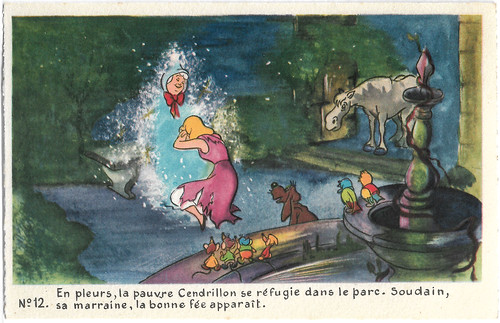
French postcard by Editions Superluxe, Paris, no. 12. Picture: Walt Disney Productions. Publicity still for Cinderella (Clyde Geronimi, Wilfred Jackson, Hamilton Luske, 1950). Caption: In tears, poor Cinderella takes refuge in the park. Suddenly, her godmother, the good fairy appears.

French postcard by Editions Superluxe, Paris, no. 13. Picture: Walt Disney Productions. Publicity still for Cinderella (Clyde Geronimi, Wilfred Jackson, Hamilton Luske, 1950). Caption: With a cup of her magic wand, the good fairy transforms a pumpkin into a magnificent coach.

French postcard by Editions Superluxe, Paris, no. 14. Picture: Walt Disney Productions. Publicity still for Cinderella (Clyde Geronimi, Wilfred Jackson, Hamilton Luske, 1950). Caption: The good fairy also transforms the Cinderella rags into a magnificent ball gown.
Cinderella (Clyde Geronimi, Wilfred Jackson, Hamilton Luske, 1950) is an adaptation of Charles Perrault's classic fairy-tale from 1697, and the film remains faithful to its origins.
Cinderella, the beautiful and kind-hearted daughter, sees her world turn upside down when her beloved mother dies, and her pained father remarries another woman, the wicked Lady Tremaine. She has two equally cruel daughters, the jealous Anastasia and Drizella.
But, once more, things will go from bad to worse, when Cinderella's father, too, dies, leaving her all alone in the Lady's clutches to serve as her maid-of-all-work.
When her cruel stepmother prevents the shabby and neglected Cinderella from attending the Royal Ball, she gets some unexpected help from the lovable mice Gus and Jaq, and from her Fairy Godmother who has quite a few tricks up her sleeve. Will she find peace and her Prince Charming?

French postcard by Editions Superluxe, Paris, no. 15. Picture: Walt Disney Productions. Postcard for Cinderella (Clyde Geronimi, Wilfred Jackson, Hamilton Luske, 1950). Caption: In the carriage of the good fairy, Cinderella goes to the Royal Ball.
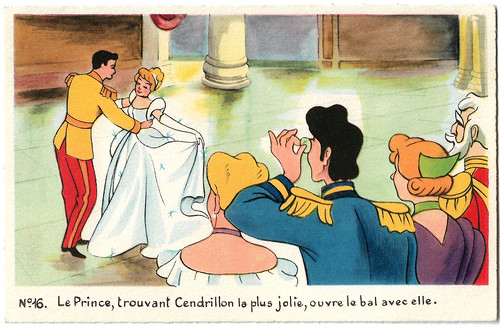
French postcard by Editions Superluxe, Paris, no. 16. Picture: Walt Disney Productions. Publicity still for Cinderella (Clyde Geronimi, Wilfred Jackson, Hamilton Luske, 1950). Caption: The Prince, finding Cinderella the prettiest, opens the ball with her.

French postcard by Editions Superluxe, Paris, no. 17. Picture: Walt Disney Productions. Publicity still for Cinderella (Clyde Geronimi, Wilfred Jackson, Hamilton Luske, 1950). Caption: But the magic effect of the good fairy must end at midnight. Cinderella, in her flight, loses a glass shoe.

French postcard by Editions Superluxe, Paris, no. 18. Picture: Walt Disney Productions. Publicity still for Cinderella (Clyde Geronimi, Wilfred Jackson, Hamilton Luske, 1950). Caption: The Prince makes Cinderella's carriage follow because he would like to know her name.

French postcard by Editions Superluxe, Paris, no. 19. Picture: Walt Disney Productions. Postcard for Cinderella (Clyde Geronimi, Wilfred Jackson, Hamilton Luske, 1950). Caption: At exactly midnight, the magic effect having ended, Cinderella is in rags in the park.
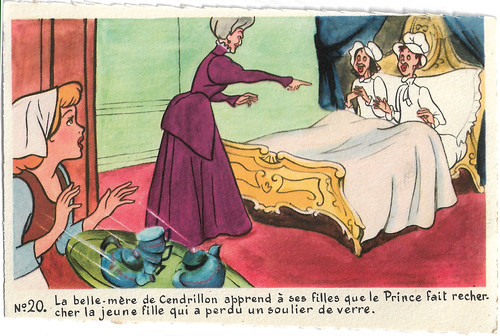
French postcard by Editions Superluxe, Paris, no. 20. Picture: Walt Disney Productions. Publicity still for Cinderella (Clyde Geronimi, Wilfred Jackson, Hamilton Luske, 1950). Caption: Cinderella's mother-in-law tells her daughters that the Prince is looking for the young girl who has lost a glass shoe.
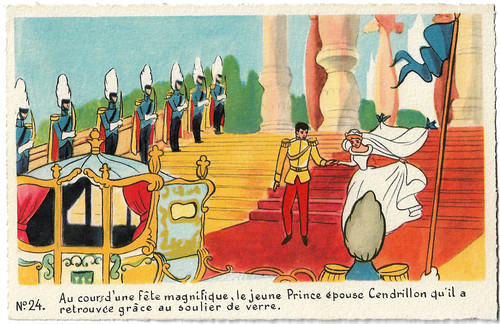
French postcard by Editions Superluxe, Paris, no. 24. Picture: Walt Disney Productions. Publicity still for Cinderella (Clyde Geronimi, Wilfred Jackson, Hamilton Luske, 1950). Caption: During a magnificent party, the young Prince marries Cinderella whom he found thanks to the glass shoe.
Cinderella (Clyde Geronimi, Wilfred Jackson, Hamilton Luske, 1950) is seen as both an end and beginning for different eras of the Disney animation studio.
The 1930s and early 1940s produced the most critically acclaimed of the Disney animated films, often groundbreaking and experimental in nature, though several of them were commercial flops.
Walt Disney Productions had suffered from losing connections to the European film markets due to the outbreak of World War II, enduring some box office bombs like Pinocchio (1940), Fantasia (1940), and Bambi (1942). The studio was over $4 million in debt and was on the verge of bankruptcy.
The rest of the 1940s involved the release of cheaper package films, films consisting of several short films combined into one. Cinderella was arguably the last product of Disney's 'golden age' and was the first of a new series of lavishly produced full-length feature films.
The Disney animated films of the 1950s were in general less artistic and experimental, more commercial in nature. Most of them were box office hits but their critical evaluation often places them below their predecessors. Made on the cusp between the two eras, Cinderella is representative of both eras.

Italian postcard by Grafiche Biondetti, Verona, no. 104/6. Picture: Walt Disney Productions. Publicity still for Cinderella (Clyde Geronimi, Wilfred Jackson, Hamilton Luske, 1950).

British postcard in the Disney Archive Collection by The Art Group Ltd., no. 8756. Picture: Disney. Publicity still for Cinderella (Clyde Geronimi, Wilfred Jackson, Hamilton Luske, 1950). Caption: The mice make Cinderella a dress.

Italian postcard by Grafiche Biondetti, Verona, no. 104. Picture: Walt Disney Productions. Publicity still for Cinderella (Clyde Geronimi, Wilfred Jackson, Hamilton Luske, 1950).
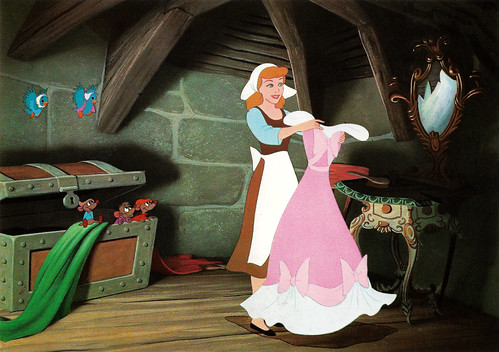
Italian postcard by Grafiche Biondetti, Verona, no. 104. Picture: Walt Disney Productions. Publicity still for Cinderella (Clyde Geronimi, Wilfred Jackson, Hamilton Luske, 1950).

Dutch postcard by Interstat, Amsterdam. Picture: Disney. Publicity still for Cinderella (Clyde Geronimi, Wilfred Jackson, Hamilton Luske, 1950).
Cinderella (Clyde Geronimi, Wilfred Jackson, Hamilton Luske, 1950) received three Oscar nominations and became the greatest critical and commercial hit for the Disney studio since Snow White and the Seven Dwarfs (1937), and helped to reverse the studio's fortunes.
Among the artists responsible for the 'look' of Cinderella (1950), was Mary Blair, whose inspired use of colour was greatly admired by Disney. Her elegant French-period backgrounds add tremendously to the quality of the film.
But, most important of all' are the believable characters - from Cinderella, right down to Lucifer, the stepmother's deliciously evil black cat. They bring both life and vibrancy to the often-told story, something very difficult to create in an animated film.
Disney gave the mice a big role in the main storyline, and this was the key to providing all the humour and suspense needed to spice up the predictable story. The leading mice, Gus and Jaq are delightful creations and the valiant band of mice is given amusing bits of business.
A highlight is the 'Cinderella Work Song' in which the mice make a dress for the mistreated Cinderella, full of inventive comic touches and accompanied by the intricate blend of song and animation. Mack David, Jerry Livingston, and Al Hoffman wrote the songs for Cinderella.

French postcard in the Le Monde Merveilleux de Walt Disney series by Diffusion Hachette, no. 104. Picture: Walt Disney Production. Publicity still for Cinderella (Clyde Geronimi, Wilfred Jackson, Hamilton Luske, 1950).
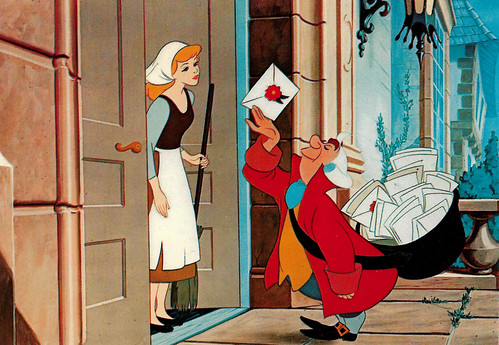
French postcard by Editions G. Picard, Paris, no. WD 6/32. Picture: Walt Disney Productions. Publicity still for Cinderella (Clyde Geronimi, Wilfred Jackson, Hamilton Luske, 1950).
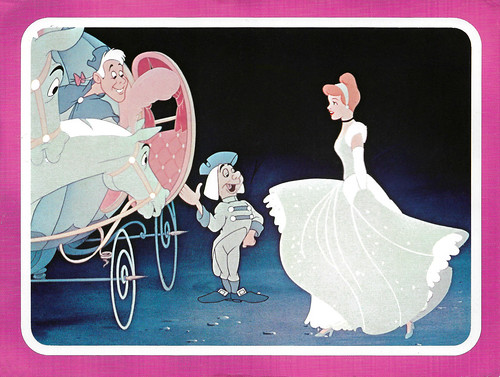
American postcard by Classico San Francisco in the Walt Disney's Classics series, no. 511-015. Image: The Walt Disney Company. Publicity still for Cinderella (Clyde Geronimi, Wilfred Jackson, Hamilton Luske, 1950).

Italian postcard by Grafiche Biondetti, Verona, no. 104. Picture: Walt Disney Productions. Publicity still for Cinderella (Clyde Geronimi, Wilfred Jackson, Hamilton Luske, 1950).
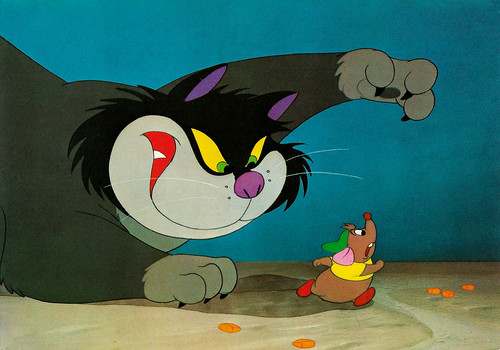
Italian postcard by Grafiche Biondetti, Verona, no. 104. Picture: Walt Disney Productions. Publicity still for Cinderella (Clyde Geronimi, Wilfred Jackson, Hamilton Luske, 1950).
Sources: Wikipedia and IMDb.

French postcard by Editions Superluxe, Paris, no. 4. Picture: Walt Disney Productions. Publicity still for Cinderella (Clyde Geronimi, Wilfred Jackson, Hamilton Luske, 1950). Caption: Cinderella's mother-in-law and two sisters-in-law ring her impatiently for her to bring them breakfast.

French postcard by Editions Superluxe, Paris, no. 5. Picture: Walt Disney Productions. Publicity still for Cinderella (Clyde Geronimi, Wilfred Jackson, Hamilton Luske, 1950). Caption: Cinderella, like every morning, brings breakfast to her nasty mother-in-law and sisters-in-law who are still in bed.

French postcard by Editions Superluxe, Paris, no. 9. Picture: Walt Disney Productions. Publicity still for Cinderella (Clyde Geronimi, Wilfred Jackson, Hamilton Luske, 1950). Caption: Cinderella, too, would like to go to the King's Ball.

French postcard by Editions Superluxe, Paris, no. 11. Picture: Walt Disney Productions. Publicity still for Cinderella (Clyde Geronimi, Wilfred Jackson, Hamilton Luske, 1950). Caption: Jealous of her beauty, Cinderella's ugly sisters-in-law tear her ball gown.

French postcard by Editions Superluxe, Paris, no. 12. Picture: Walt Disney Productions. Publicity still for Cinderella (Clyde Geronimi, Wilfred Jackson, Hamilton Luske, 1950). Caption: In tears, poor Cinderella takes refuge in the park. Suddenly, her godmother, the good fairy appears.

French postcard by Editions Superluxe, Paris, no. 13. Picture: Walt Disney Productions. Publicity still for Cinderella (Clyde Geronimi, Wilfred Jackson, Hamilton Luske, 1950). Caption: With a cup of her magic wand, the good fairy transforms a pumpkin into a magnificent coach.

French postcard by Editions Superluxe, Paris, no. 14. Picture: Walt Disney Productions. Publicity still for Cinderella (Clyde Geronimi, Wilfred Jackson, Hamilton Luske, 1950). Caption: The good fairy also transforms the Cinderella rags into a magnificent ball gown.
A classic fairy-tale from 1697
Cinderella (Clyde Geronimi, Wilfred Jackson, Hamilton Luske, 1950) is an adaptation of Charles Perrault's classic fairy-tale from 1697, and the film remains faithful to its origins.
Cinderella, the beautiful and kind-hearted daughter, sees her world turn upside down when her beloved mother dies, and her pained father remarries another woman, the wicked Lady Tremaine. She has two equally cruel daughters, the jealous Anastasia and Drizella.
But, once more, things will go from bad to worse, when Cinderella's father, too, dies, leaving her all alone in the Lady's clutches to serve as her maid-of-all-work.
When her cruel stepmother prevents the shabby and neglected Cinderella from attending the Royal Ball, she gets some unexpected help from the lovable mice Gus and Jaq, and from her Fairy Godmother who has quite a few tricks up her sleeve. Will she find peace and her Prince Charming?

French postcard by Editions Superluxe, Paris, no. 15. Picture: Walt Disney Productions. Postcard for Cinderella (Clyde Geronimi, Wilfred Jackson, Hamilton Luske, 1950). Caption: In the carriage of the good fairy, Cinderella goes to the Royal Ball.

French postcard by Editions Superluxe, Paris, no. 16. Picture: Walt Disney Productions. Publicity still for Cinderella (Clyde Geronimi, Wilfred Jackson, Hamilton Luske, 1950). Caption: The Prince, finding Cinderella the prettiest, opens the ball with her.

French postcard by Editions Superluxe, Paris, no. 17. Picture: Walt Disney Productions. Publicity still for Cinderella (Clyde Geronimi, Wilfred Jackson, Hamilton Luske, 1950). Caption: But the magic effect of the good fairy must end at midnight. Cinderella, in her flight, loses a glass shoe.

French postcard by Editions Superluxe, Paris, no. 18. Picture: Walt Disney Productions. Publicity still for Cinderella (Clyde Geronimi, Wilfred Jackson, Hamilton Luske, 1950). Caption: The Prince makes Cinderella's carriage follow because he would like to know her name.

French postcard by Editions Superluxe, Paris, no. 19. Picture: Walt Disney Productions. Postcard for Cinderella (Clyde Geronimi, Wilfred Jackson, Hamilton Luske, 1950). Caption: At exactly midnight, the magic effect having ended, Cinderella is in rags in the park.

French postcard by Editions Superluxe, Paris, no. 20. Picture: Walt Disney Productions. Publicity still for Cinderella (Clyde Geronimi, Wilfred Jackson, Hamilton Luske, 1950). Caption: Cinderella's mother-in-law tells her daughters that the Prince is looking for the young girl who has lost a glass shoe.

French postcard by Editions Superluxe, Paris, no. 24. Picture: Walt Disney Productions. Publicity still for Cinderella (Clyde Geronimi, Wilfred Jackson, Hamilton Luske, 1950). Caption: During a magnificent party, the young Prince marries Cinderella whom he found thanks to the glass shoe.
The last product of Disney's 'golden age'
Cinderella (Clyde Geronimi, Wilfred Jackson, Hamilton Luske, 1950) is seen as both an end and beginning for different eras of the Disney animation studio.
The 1930s and early 1940s produced the most critically acclaimed of the Disney animated films, often groundbreaking and experimental in nature, though several of them were commercial flops.
Walt Disney Productions had suffered from losing connections to the European film markets due to the outbreak of World War II, enduring some box office bombs like Pinocchio (1940), Fantasia (1940), and Bambi (1942). The studio was over $4 million in debt and was on the verge of bankruptcy.
The rest of the 1940s involved the release of cheaper package films, films consisting of several short films combined into one. Cinderella was arguably the last product of Disney's 'golden age' and was the first of a new series of lavishly produced full-length feature films.
The Disney animated films of the 1950s were in general less artistic and experimental, more commercial in nature. Most of them were box office hits but their critical evaluation often places them below their predecessors. Made on the cusp between the two eras, Cinderella is representative of both eras.

Italian postcard by Grafiche Biondetti, Verona, no. 104/6. Picture: Walt Disney Productions. Publicity still for Cinderella (Clyde Geronimi, Wilfred Jackson, Hamilton Luske, 1950).

British postcard in the Disney Archive Collection by The Art Group Ltd., no. 8756. Picture: Disney. Publicity still for Cinderella (Clyde Geronimi, Wilfred Jackson, Hamilton Luske, 1950). Caption: The mice make Cinderella a dress.

Italian postcard by Grafiche Biondetti, Verona, no. 104. Picture: Walt Disney Productions. Publicity still for Cinderella (Clyde Geronimi, Wilfred Jackson, Hamilton Luske, 1950).

Italian postcard by Grafiche Biondetti, Verona, no. 104. Picture: Walt Disney Productions. Publicity still for Cinderella (Clyde Geronimi, Wilfred Jackson, Hamilton Luske, 1950).

Dutch postcard by Interstat, Amsterdam. Picture: Disney. Publicity still for Cinderella (Clyde Geronimi, Wilfred Jackson, Hamilton Luske, 1950).
Full of inventive comic touches
Cinderella (Clyde Geronimi, Wilfred Jackson, Hamilton Luske, 1950) received three Oscar nominations and became the greatest critical and commercial hit for the Disney studio since Snow White and the Seven Dwarfs (1937), and helped to reverse the studio's fortunes.
Among the artists responsible for the 'look' of Cinderella (1950), was Mary Blair, whose inspired use of colour was greatly admired by Disney. Her elegant French-period backgrounds add tremendously to the quality of the film.
But, most important of all' are the believable characters - from Cinderella, right down to Lucifer, the stepmother's deliciously evil black cat. They bring both life and vibrancy to the often-told story, something very difficult to create in an animated film.
Disney gave the mice a big role in the main storyline, and this was the key to providing all the humour and suspense needed to spice up the predictable story. The leading mice, Gus and Jaq are delightful creations and the valiant band of mice is given amusing bits of business.
A highlight is the 'Cinderella Work Song' in which the mice make a dress for the mistreated Cinderella, full of inventive comic touches and accompanied by the intricate blend of song and animation. Mack David, Jerry Livingston, and Al Hoffman wrote the songs for Cinderella.

French postcard in the Le Monde Merveilleux de Walt Disney series by Diffusion Hachette, no. 104. Picture: Walt Disney Production. Publicity still for Cinderella (Clyde Geronimi, Wilfred Jackson, Hamilton Luske, 1950).

French postcard by Editions G. Picard, Paris, no. WD 6/32. Picture: Walt Disney Productions. Publicity still for Cinderella (Clyde Geronimi, Wilfred Jackson, Hamilton Luske, 1950).

American postcard by Classico San Francisco in the Walt Disney's Classics series, no. 511-015. Image: The Walt Disney Company. Publicity still for Cinderella (Clyde Geronimi, Wilfred Jackson, Hamilton Luske, 1950).

Italian postcard by Grafiche Biondetti, Verona, no. 104. Picture: Walt Disney Productions. Publicity still for Cinderella (Clyde Geronimi, Wilfred Jackson, Hamilton Luske, 1950).

Italian postcard by Grafiche Biondetti, Verona, no. 104. Picture: Walt Disney Productions. Publicity still for Cinderella (Clyde Geronimi, Wilfred Jackson, Hamilton Luske, 1950).
Sources: Wikipedia and IMDb.
Hi, Paul, thank you for checking in. I've been out of touch with everyone. It's been a difficult time since Thanksgiving. I am doing much better now, but our family has been through it. Lost an uncle, an aunt and my sis in law is in the hospital...
ReplyDeleteBut with God and family, one can get through the hard times. Blessing and peace, my Friend. And greetings from the USA, Mid-Willamette Valley of Oregon. <3
So...what's your good news?! :D
ReplyDelete